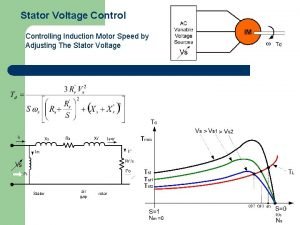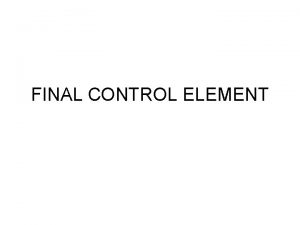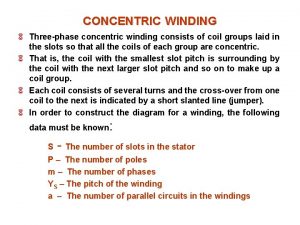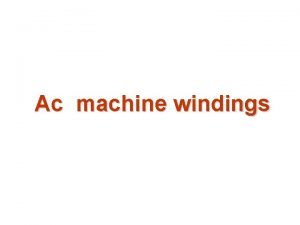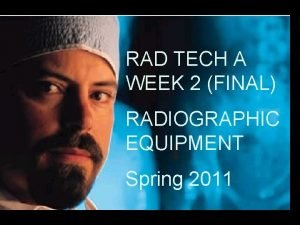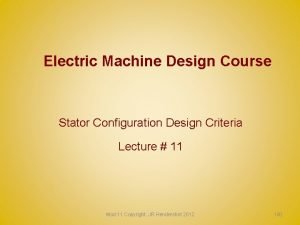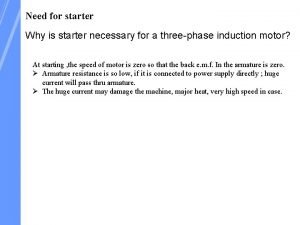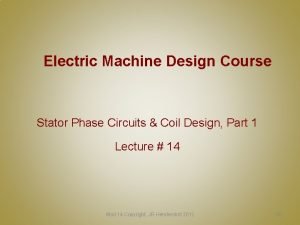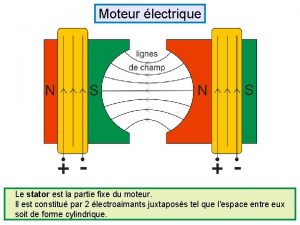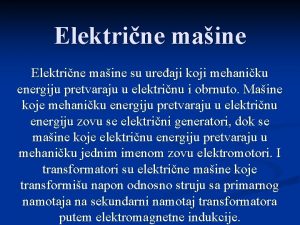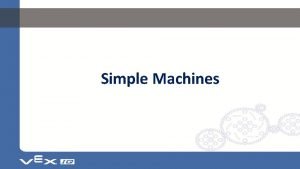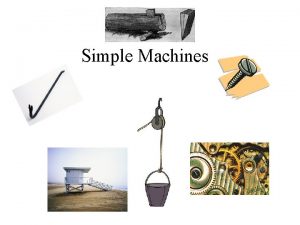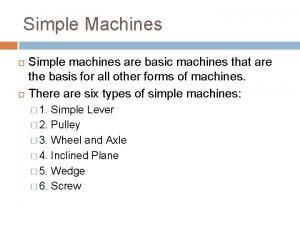Induction Machines Simple Stator winding is similar to












- Slides: 12

Induction Machines • • Simple! Stator winding is similar to that of synchronous machine! Mostly used as motors. No separate excitation is required for the rotor. The rotor typically consists of one of two arrangements: – Squirrel cage. – Wound rotor. Induction motor operates by virtue of currents induced from the stator field in the rotor. Speed of rotation n is below the synchronous speed ns. See eq. 17. 73 for the slip. Solve Ex 17. 12; 17. 13; 17. 14 0

Squirrel cage induction motor; (b) conductors in rotor; (c) photograph of squirrel cage induction motor; (d) views of Smokin’ Buckey motor: rotor, stator, and cross section of stator (Courtesy: David H. Koether Photography ) Figure 17. 37 1

Circuit model for induction machine Figure 17. 38 2

Equivalent circuit of an induction machine Figure 17. 40 3

Performance curve for induction motor Figure 17. 42 4

General configuration of adjustable-frequency drive Figure 17. 45 5

Single-Phase Motors • Single-phase motors are used mostly to operate home appliances such as air conditioners, refrigerators, pumps, and fans. • They are designed to operate on 120 V or 240 V. • They range in capacity from fractional horsepower to several horsepower depending on the application. • Voltage is induced in the rotor as a result of magnetic induction, and a magnetic field is produced around the rotor. This field will always be in opposition to the stator field (according to Lenz’s law). 6

Split-Phase Motors Split-phase motors use inductance, capacitance, or resistance to develop a starting torque. These motors split the current flow through two separate windings to simulate a two-phase power system. A rotating magnetic field can be produced with a twophase system. • There are three types of split-phase motors depending on the means of starting: – The resistance-start induction-run motor. – The capacitor-start induction-run motor. 7

The Resistance-Start Induction-Run Motor • The out-of-phase condition between start and run winding current is caused by the start winding having more resistance than the run winding. • The amount of starting torque produced is determined by: – The strength of the magnetic field of the stator. – The strength of the magnetic field of the rotor. – The phase angle difference between current in the start winding and current in the run winding (maximum torque is achieved when these two currents are 90 o out of phase with each other). 8

The main winding has a high inductance and a low resistance. The current lags the voltage by a large angle. The starting winding have a low inductance and a high resistance. The current lags the voltage by a smaller angle. Suppose the current in the main winding lags the voltage by 80°. The current in the auxiliary winding lags the voltage by 40°. The currents are, hence, out of phase by 40°, which is enough to generate rotating field. Main Winding, L and R Starting Winding Main Supply Rotor R 9

The Capacitor-Start Induction-Run Motor • The stator consists of the main winding and a starting winding. The starting winding is connected in parallel with the main winding and is placed at right angles to it. • A 90 -degree electrical phase difference between the two windings is obtained by connecting the auxiliary winding in series with a capacitor and a starting switch. When the motor is energized, the starting switch is closed. This places the capacitor in series with the auxiliary winding. • Now we will have an RC circuit (Starting winding and the capacitor) and an RL circuit (main winding). The currents in each winding are therefore 90° out of phase, so are the magnetic fields that are generated. 10

When nearly full speed is obtained, a centrifugal device (the switch) cuts out the starting winding. The motor then runs as a single-phase induction motor. • Main Winding Rotor Power Supply Switch Starting Winding Capacitor 11
